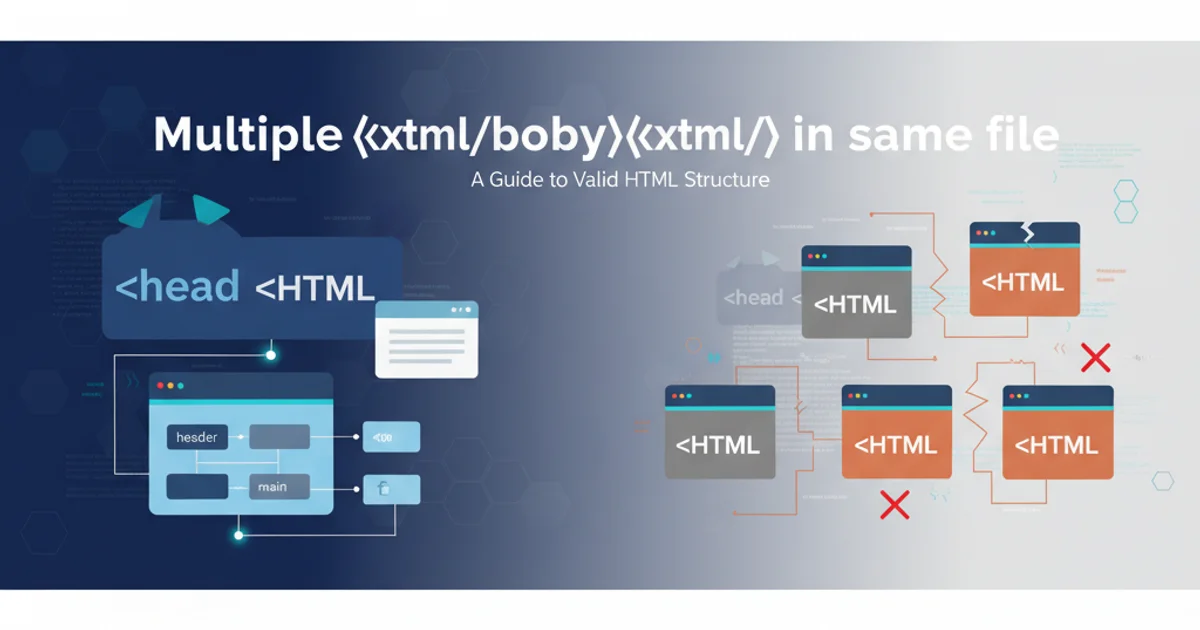Multiple <html><body> </html></body> in same file
Categories:
Understanding and Avoiding MultipleTags in HTML

Explore why having multiple <html> or <body> tags in a single HTML document is invalid, the problems it causes, and how to correctly structure your web pages.
In web development, adhering to proper HTML structure is fundamental for creating robust, accessible, and maintainable web pages. A common misconception or error, especially for beginners, is the idea of using multiple <html> or <body> tags within a single HTML file. This article delves into why this practice is incorrect, the issues it introduces, and the correct approach to structuring your HTML documents.
The Uniqueness ofand Elements
According to the HTML specification, both the <html> and <body> elements are unique root-level containers. An HTML document must have exactly one <html> element, which serves as the root of the entire document. Similarly, there must be exactly one <body> element, which contains all the visible content of the web page. Introducing more than one of these elements breaks the fundamental structure of an HTML document.
flowchart TD
A["HTML Document"] --> B["<html> (Root Element)"]
B --> C["<head> (Metadata)"]
B --> D["<body> (Visible Content)"]
D --> E["Multiple Child Elements (e.g., <div>, <p>, <img>)"]
style A fill:#f9f,stroke:#333,stroke-width:2px
style B fill:#bbf,stroke:#333,stroke-width:2px
style C fill:#ccf,stroke:#333,stroke-width:2px
style D fill:#ddf,stroke:#333,stroke-width:2px
style E fill:#eef,stroke:#333,stroke-width:2pxCorrect HTML Document Structure
Why Multiple Tags Cause Problems
Using multiple <html> or <body> tags can lead to a myriad of issues, impacting rendering, scripting, and SEO. Browsers are designed to parse a single, well-defined document tree. When they encounter multiple root or body elements, their behavior becomes unpredictable. This can result in:
- Inconsistent Rendering: Different browsers might interpret the invalid structure in varying ways, leading to inconsistent visual presentation across platforms.
- JavaScript Errors: JavaScript often relies on a predictable DOM (Document Object Model) structure. Multiple
<body>elements can confuse DOM manipulation methods, causing scripts to fail or behave unexpectedly. - CSS Styling Issues: Stylesheets might not apply correctly, as the browser struggles to determine which
<body>or<html>element is the authoritative one. - Accessibility Problems: Screen readers and other assistive technologies depend on a standard document structure to convey information effectively. An invalid structure can severely hinder accessibility.
- SEO Penalties: Search engine crawlers prefer well-formed HTML. Invalid structures can make it harder for search engines to parse and index your content, potentially harming your search rankings.
- Validation Failures: HTML validators will flag these as critical errors, indicating non-compliance with web standards.
<html> or <body> tags in a single HTML file. This violates HTML specifications and leads to unpredictable behavior across browsers and tools.Correctly Structuring Your HTML
The solution is straightforward: ensure your HTML document contains only one <html> element and one <body> element. All your visible content, including headings, paragraphs, images, links, and scripts, should reside within this single <body> tag. If you need to organize content into distinct sections, use semantic HTML5 elements like <header>, <main>, <nav>, <aside>, <footer>, or generic <div> elements.
<!DOCTYPE html>
<html lang="en">
<head>
<meta charset="UTF-8">
<meta name="viewport" content="width=device-width, initial-scale=1.0">
<title>My Valid Web Page</title>
<link rel="stylesheet" href="styles.css">
</head>
<body>
<header>
<h1>Welcome to My Site</h1>
<nav>
<ul>
<li><a href="#home">Home</a></li>
<li><a href="#about">About</a></li>
</ul>
</nav>
</header>
<main>
<section id="home">
<h2>Home Section</h2>
<p>This is the main content of the home page.</p>
</section>
<section id="about">
<h2>About Us</h2>
<p>Learn more about our mission.</p>
</section>
</main>
<footer>
<p>© 2023 My Company</p>
</footer>
<script src="script.js"></script>
</body>
</html>
Example of a correctly structured HTML document.
<html> and <body> structure. Tools like browser developer consoles and HTML validators can help identify such issues.